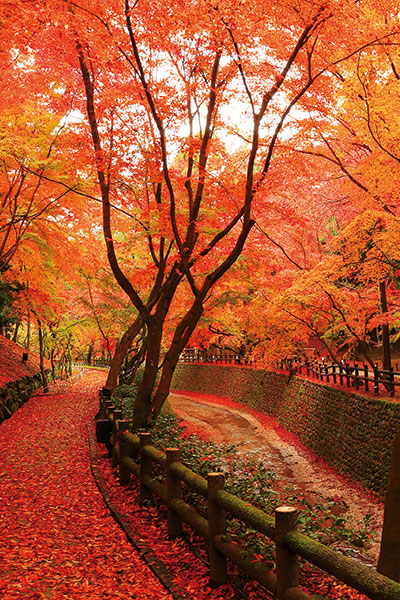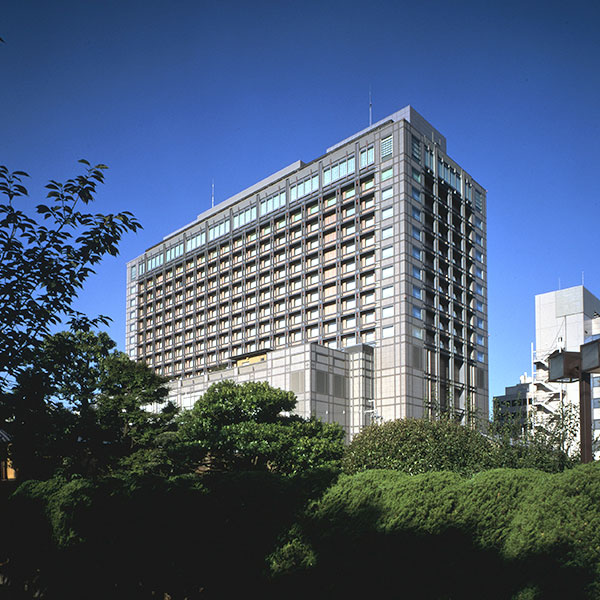Kyoto (Part 1)
A View in Perfect Harmony
Kitano Tenmangu in Kyoto is the foremost shrine of around 12,000 Tenmangu and Tenjin shrines across the country, and is affectionately known by locals as Kitano no Tenjin-san.
Enshrined here is Sugawara no Michizane, revered as the god of learning. A poem he once composed asks the gods to accept the beauty of the leaves as they are, showing the love that he had for autumn foliage. Along the Kamiyagawa River, which flows through the shrine grounds, is a more than 400-year-old maple tree known as the Mitsumata-no-momiji. This together with the approximately 350 others in the natural forest have been valued and protected for centuries.
These charming trees and their colorful autumn leaves present a harmonious vista alongside the Odoi, an old earthen fortification built by Toyotomi Hideyoshi.
The Odoi was once a five-meter-high earthen wall that surrounded the city of Kyoto. The majority of it has now disappeared, however, and so the remains of the wall inside Kitano Tenmangu are particularly valued.

The area around the Odoi is known as the Momiji-en, or maple garden, and since 2007, it has been exclusively open for public viewing during the autumn leaves season. The serenity of the walking path that traverses the vermillion Uguisubashi Bridge and viewing points is majestic in its own right; perhaps even better, though, is the stunning atmosphere presented by the illuminations and the performances by maiko from Kamishichiken, the oldest entertainment district in Kyoto. In the autumn of 1587, a tea ceremony of unprecedented scale was hosted here by Toyotomi Hideyoshi. For an experience unique to Kyoto, visitors to the shrine can take part in a tea ceremony inspired by this historical event, in which they are served tea snacks known as Kitano-Ochanoyu, said to be modeled on funo-yaki, a snack favored by the tea ceremony pioneer Sen no Rikyu.

Tofuku-ji is the head temple of the Tofukuji school of the Rinzai sect of Buddhism. In addition to the Sanmon Gate, a national treasure, and the Japanese rock garden designed by Mirei Shigemori, a leading landscape architect of the Showa period, the ancient Tofuku-ji Temple is also famous for its autumn leaves.
The most spectacular views are offered by the Sengyokukan gorge, where mitsuba-kaede trees of Chinese origin from the time the temple was established shine a golden yellow. In late autumn, the rich colors of the leaves present an unparalleled sight.
Complementing this view are the temple’s three famous roofed wooden bridges: Gaun-kyo, Tsuten-kyo, and Engetsu-kyo. Although all the bridges boast the typical grace of a Zen temple, the most popular for viewing the autumn leaves is Tsuten-kyo. From the corridor-like, refined structure, the entire view is of autumn foliage, and the depth of the gorge makes for an impressive sight. There can’t be many bridges in the world which are as alluring as this one.
There is much more to Tofuku-ji Temple, however, such as the Honbo garden, which has been designated a national site of scenic beauty. Also designed by Mirei Shigemori, the playful rock garden is a relaxing sight alongside the reds of autumn.

*This page is referred to One Harmony Membership Magazine YAWARAGI Vol.40
Hotel Okura Kyoto

Established in 1888, Hotel Okura Kyoto is one of the city’s leading hotels, welcoming important guests from Japan and abroad and known for its outstanding hospitality.
It is located in the center of the city at Kawaramachi-oike, just a short walk from the Kamogawa River, and with seventeen floors above ground, visitors can enjoy panoramic views of the entire city and the Higashiyama Sanju-roppo mountain range.
